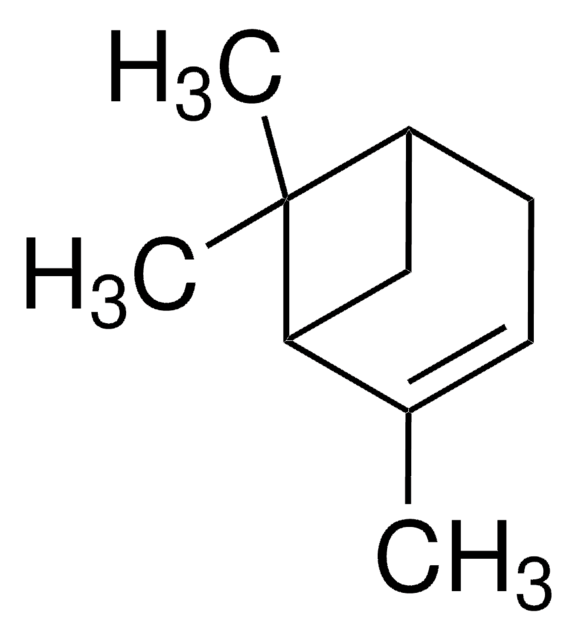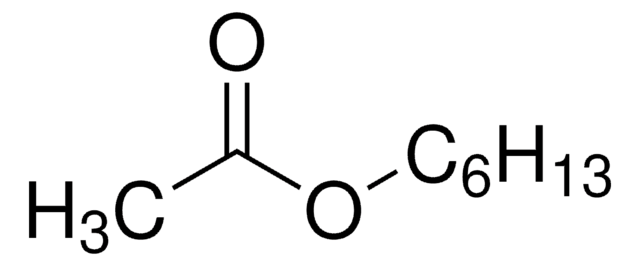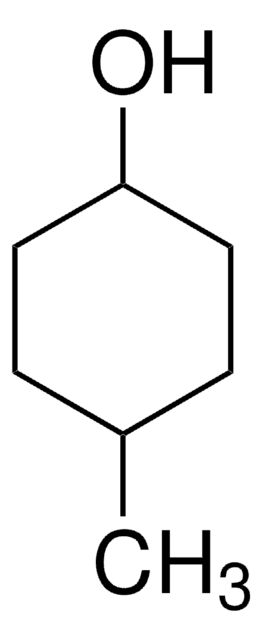112674
Isopentyl acetate
mixture of isomers, reagent grade, 98%
Sinónimos:
Acetic acid 3-methylbutyl ester, Isoamyl acetate
About This Item
Productos recomendados
grado
reagent grade
Nivel de calidad
densidad de vapor
4.5 (vs air)
presión de vapor
5 mmHg ( 25 °C)
Ensayo
98%
Formulario
liquid
temp. de autoignición
680 °F
lim. expl.
7.5 %
dilution
(for analytical testing)
índice de refracción
n20/D 1.4 (lit.)
bp
142 °C/756 mmHg (lit.)
mp
−78 °C (lit.)
densidad
0.876 g/mL at 25 °C (lit.)
cadena SMILES
CC(C)CCOC(C)=O
InChI
1S/C7H14O2/c1-6(2)4-5-9-7(3)8/h6H,4-5H2,1-3H3
Clave InChI
MLFHJEHSLIIPHL-UHFFFAOYSA-N
¿Está buscando productos similares? Visita Guía de comparación de productos
Descripción general
Aplicación
- Development of a safety analysis method for volatile organic compounds using 2-phenoxyethanol as solvent.: This study developed a novel method for analyzing the safety of volatile organic compounds, including Isopentyl acetate, using 2-phenoxyethanol as a solvent. The method enhances the detection and quantification of these compounds in various matrices, which is crucial for ensuring safety standards in industrial applications (Wang et al., 2024).
- Addition of Saccharomyces eubayanus to SCOBY fermentations modulates the chemical and volatile compound profiles in kombucha.: This research demonstrated that introducing Saccharomyces eubayanus to kombucha fermentation alters its chemical and volatile profiles, including an increase in Isopentyl acetate, which impacts the beverage′s aroma and flavor profile (Venegas et al., 2023).
- Honey Bee Colonies (Apis mellifera L.) Perform Orientation Defensiveness That Varies among Bred Lines.: This article explored the behavioral responses of honey bee colonies to different volatile compounds, including Isopentyl acetate, finding variations in orientation defensiveness among different bred lines of bees (Akongte et al., 2023).
- Discovering Aethina tumida responses to attractant and repellent molecules: A potential basis for future management strategies.: The study investigated the responses of Aethina tumida (small hive beetle) to various attractant and repellent molecules, including Isopentyl acetate, which could inform future pest management strategies in apiculture (Roth et al., 2023).
- A Targeted and an Untargeted Metabolomics Approach to the Volatile Aroma Profile of Young ′Martina′ Wines.: This research utilized both targeted and untargeted metabolomics to analyze the aroma profile of young ′Martina′ wines, identifying Isopentyl acetate as a significant contributor to the wine′s volatile profile (Boban et al., 2022).
Palabra de señalización
Warning
Frases de peligro
Consejos de prudencia
Clasificaciones de peligro
Flam. Liq. 3
Riesgos supl.
Código de clase de almacenamiento
3 - Flammable liquids
Clase de riesgo para el agua (WGK)
WGK 1
Punto de inflamabilidad (°F)
91.4 °F - closed cup
Punto de inflamabilidad (°C)
33 °C - closed cup
Elija entre una de las versiones más recientes:
¿Ya tiene este producto?
Encuentre la documentación para los productos que ha comprado recientemente en la Biblioteca de documentos.
Los clientes también vieron
Nuestro equipo de científicos tiene experiencia en todas las áreas de investigación: Ciencias de la vida, Ciencia de los materiales, Síntesis química, Cromatografía, Analítica y muchas otras.
Póngase en contacto con el Servicio técnico









